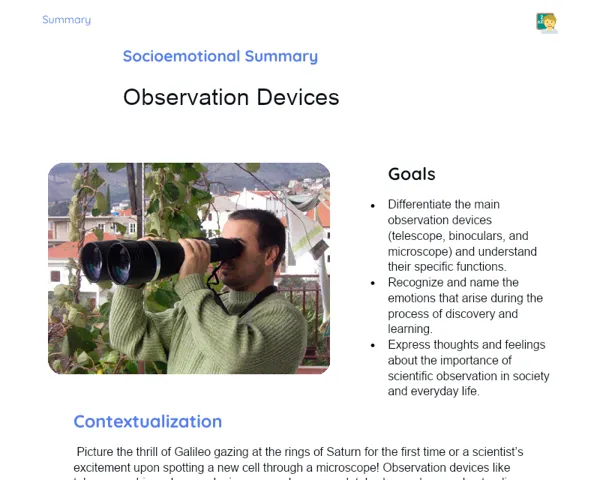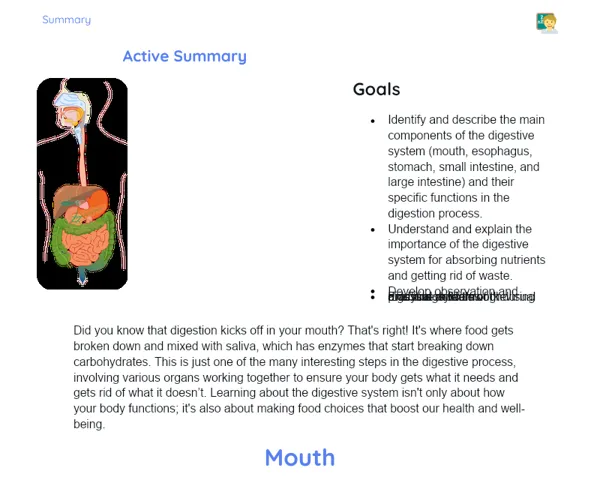Summary Tradisional | Environmental Balance
Contextualization
Environmental balance refers to the harmonious relationship between living organisms and their environments. This balance is crucial for the proper functioning of ecosystems, facilitating a sustainable coexistence among plants, animals, and humans. It encompasses various elements such as the availability of natural resources, predator-prey dynamics, and appropriate climatic conditions. Any disruption in these factors can result in significant imbalances that negatively impact all forms of life.
It’s important to recognize that environmental balance is dynamic and influenced by both natural elements and human activities. For instance, phenomena like climate change, deforestation, and pollution are ways in which human actions can upset this balance. Sustaining environmental balance is vital for preserving biodiversity and ensuring ecosystems remain healthy. Without this balance, ecosystems may struggle to provide essential services that are critical for life, such as clean water, oxygen, and climate stability.
To Remember!
Definition of Environmental Balance
Environmental balance is a stable state where living (biotic) and non-living (abiotic) components of an ecosystem interact in a harmonious way. This interaction is essential for maintaining conditions that support life. The mutual dependence between organisms and their environment is crucial for a sustainable ecosystem.
Achieving this balance means having an appropriate supply of natural resources like water and nutrients, and a suitable representation of various species fulfilling their roles in food webs. When any of these components are disrupted, either through natural events or human interference, it can lead to ecological imbalances that pose risks for the environment and organisms relying on it.
For example, if a predator's population drops suddenly, its prey may proliferate, exhausting the resources available in the ecosystem and ultimately leading to habitat damage. Thus, it’s vital to maintain environmental balance for the health and sustainability of ecosystems.
-
Stable interaction between living and non-living components.
-
Key interdependence for ecosystem sustainability.
-
Disruption of elements can cause imbalance and degradation.
Factors Influencing Environmental Balance
A variety of factors impact environmental balance, including the availability of natural resources, predator-prey relationships, climatic conditions, and biogeochemical cycles. Access to natural resources, such as water, sunlight, and nutrients, is essential for the survival of all living things. Any changes to the quantity or quality of these resources can have adverse effects on the ecosystem.
The dynamics of predator-prey relationships are vital to manage species populations. Predators help regulate prey numbers, preventing overpopulation that could lead to habitat degradation. Likewise, the survival of predators relies on a healthy prey population.
Climatic factors, like temperature and rainfall, significantly influence ecosystem health. Climate change is altering habitats and species distributions, which can compromise environmental stability. Additionally, biogeochemical cycles, including carbon and nitrogen cycles, are critical for recycling essential nutrients, and disruptions in these cycles can harm ecosystem functionality.
-
Essential availability of natural resources for ecosystem health.
-
Predator-prey dynamics maintain population and prevent habitat degradation.
-
Climatic factors and biogeochemical cycles are key to stability.
Impacts of Human Actions
Human activities have a profound influence on environmental balance. Pollution is a major factor through which human actions destabilize ecosystems. Contaminating air, water, and soil can negatively affect the well-being of all living beings and disrupt environmental conditions necessary for survival.
Deforestation is another detrimental human activity impacting environmental balance. Clearing trees and vegetation not only decreases biodiversity but also disrupts water cycles and contributes to climate change. Loss of habitats forces species to either migrate or face extinction, undermining ecological stability.
Lastly, climate change driven by greenhouse gas emissions, especially carbon dioxide, is increasing global temperatures and altering weather patterns. These changes impact natural habitats, resource availability, and species distributions, leading to severe environmental imbalances.
-
Pollution jeopardizes ecosystem health and distorts environmental conditions.
-
Deforestation leads to biodiversity loss and contributes to climate change.
-
Climate change disrupts habitats and alters species distributions.
Initiatives for Restoring Balance
To mend environmental balance after disruption from human activities, various initiatives can be pursued. Reforestation is a key practice, involving the planting of trees and restoring damaged forest areas. This effort aids in habitat recovery, boosts biodiversity, and sequesters atmospheric carbon, alleviating climate change concerns.
Employing sustainable agricultural practices such as crop rotation, using organic fertilizers, and conservation farming are vital for combating soil degradation and enhancing ecosystem health. These methods sustain soil fertility, conserve water, and foster biodiversity.
Additionally, protecting natural areas through the establishment of parks and reserves safeguards habitats and endangered species, ensuring ecosystems can thrive sustainably. Moreover, environmental education plays a crucial role in raising awareness about the significance of environmental preservation and encouraging responsible behaviours within communities.
-
Reforestation supports habitat recovery and carbon sequestration.
-
Sustainable agriculture improves ecosystem health.
-
Preservation of natural areas and environmental education are crucial.
Key Terms
-
Environmental Balance: A stable state of interaction between living and non-living components.
-
Natural Resources: Elements like water and nutrients vital for life.
-
Predator-Prey: A relationship that regulates species populations and prevents habitat damage.
-
Climatic Conditions: Elements such as temperature and rainfall that affect balance.
-
Biogeochemical Cycles: Processes like carbon and nitrogen cycling essential for nutrient recycling.
-
Pollution: Contamination affecting the health of ecosystems.
-
Deforestation: Clearing trees leading to reduced biodiversity and disruption of natural processes.
-
Climate Change: Variations in weather patterns due to greenhouse gas emissions.
-
Reforestation: Planting trees to restore damaged ecosystems.
-
Sustainable Practices: Farming techniques that protect soil health and encourage biodiversity.
-
Conservation of Natural Areas: Efforts to protect habitats and species through parks and reserves.
-
Environmental Education: Promoting awareness about the importance of environmental conservation.
Important Conclusions
The lesson on environmental balance explored what the concept entails, the factors that influence it, and how human actions can disrupt our environment. Key topics included the role of natural resources, predator-prey dynamics, climatic influences, and biogeochemical cycles in maintaining ecosystem stability. The significant negative impacts of human activities like pollution, deforestation, and climate change were discussed and how they can upset this balance.
We also looked at various strategies to restore environmental balance, such as reforestation, sustainable farming practices, and conservation efforts. The importance of environmental education was underscored, emphasizing its role in raising awareness and encouraging sustainable behaviours within our communities. Protecting environmental balance is essential for the health of ecosystems and the survival of all species, ourselves included.
Understanding environmental balance is vital for adopting more sustainable practices and mitigating adverse effects resulting from our activities. Learners are encouraged to delve deeper into this topic, appreciating the interconnectedness of various factors influencing ecosystem health and the importance of each initiative towards preservation. This understanding is crucial for developing informed and responsible citizens committed to caring for the environment.
Study Tips
-
Review the key points discussed in class and create summaries to highlight the factors influencing environmental balance and human impacts.
-
Explore literature on sustainable practices and environmental conservation to broaden your understanding of restoration initiatives.
-
Watch documentaries and educational videos about ecosystems and climate change to see practical examples of theoretical concepts discussed in class.



